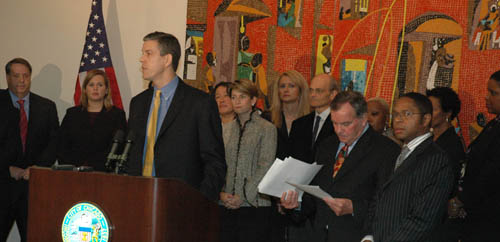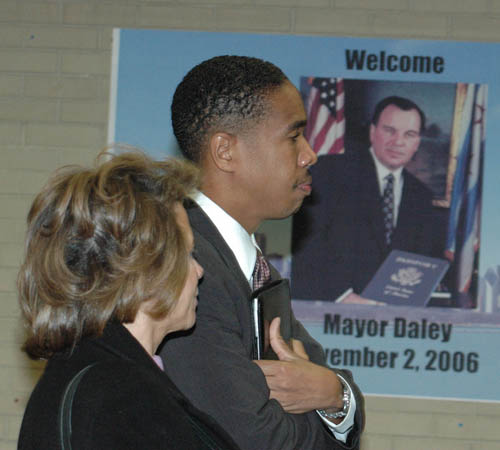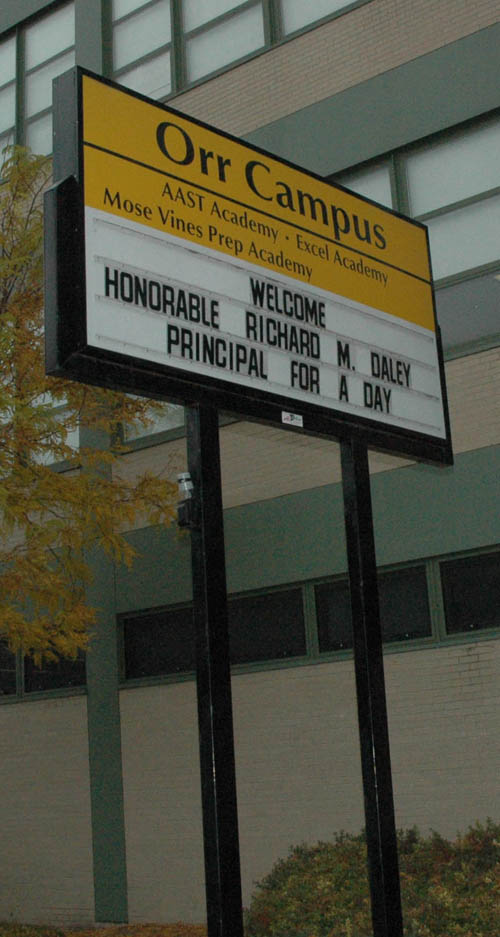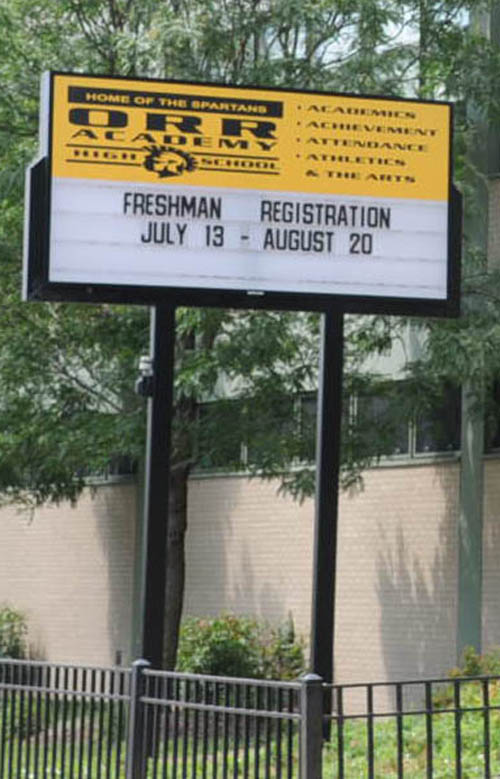MEDIA WATCH: The Orr High School stories... Turning around the turned around which had already been overturned after being turned around, interventioned, reengineered, reconstituted and probationed (among other things)
Only in a city that has a municipal and media version of dementia could the latest Orr High School story be a form of "news" with most of the context left out. During Spring Cleaning week, WBEZ listeners were treated to the most recent sage of Orr, which in its latest iteration is a "Turnaround" run by President Barack Obama's favorite corporate turnaround specialists, the Academy for Urban School Leadership (AUSL). Again.
 On November 2, 2006, (then) Chicago schools Chief Executive Officer Arne Duncan (above at podium) served as master of ceremonies for a media event at the "Orr Campus." That day, Mayor Richard M. Daley (reading papers at the right above) was "Principal for a Day" and the Bush administration's Department of Education was pledging more than $20 million for Chicago to do merit pay as another way to do corporate reform on Chicago's schools. At the time of the above photograph, Orr held three "small schools," which were part of the most recent corporate reform strategy to fix Orr. When the small schools were brought in, most of the teachers from Orr "High School" were dumped by Duncan. A year after the above photograph, Duncan proclaimed that Orr's small schools had failed, and Orr became a "turnaround school" under the Academy for Urban School Leadership (AUSL). Again, almost all of the teachers and principals from the Orr small schools were dumped, to be replaced by the superteachers and superprincial trained in the supermethods of the AUSL training center. Less than two years after the "turnaround" of Orr began, the superprincipal was fired and a new one brought in. Substance photo by George N. Schmidt. The latest contribution to Chicago's municipal amnesia is "Turnaround school gets turned around again" by WBEZ reporter Chip Mitchell. Following the traditional corporate school reform narrative for Chicago (one that dates back to the original school reform fraud exposed by Substance in 1984, the Marva Collins Hoax, which made it as far as CBS "60 Minutes" before the facts came out), the young white reporter wanders around the all-black school on a tour hosted by the energetic black reformer. The reporter then narratives the story from the point of view of the dog-and-pony show prepared carefully for him prior to his arrival, and the story becomes "news" for the benefit of the latest corporate version of fixing things in the schools while ignoring the impact of contemporary capitalism and its vicious inequities on the children from the homes near the school who are attending the school.
On November 2, 2006, (then) Chicago schools Chief Executive Officer Arne Duncan (above at podium) served as master of ceremonies for a media event at the "Orr Campus." That day, Mayor Richard M. Daley (reading papers at the right above) was "Principal for a Day" and the Bush administration's Department of Education was pledging more than $20 million for Chicago to do merit pay as another way to do corporate reform on Chicago's schools. At the time of the above photograph, Orr held three "small schools," which were part of the most recent corporate reform strategy to fix Orr. When the small schools were brought in, most of the teachers from Orr "High School" were dumped by Duncan. A year after the above photograph, Duncan proclaimed that Orr's small schools had failed, and Orr became a "turnaround school" under the Academy for Urban School Leadership (AUSL). Again, almost all of the teachers and principals from the Orr small schools were dumped, to be replaced by the superteachers and superprincial trained in the supermethods of the AUSL training center. Less than two years after the "turnaround" of Orr began, the superprincipal was fired and a new one brought in. Substance photo by George N. Schmidt. The latest contribution to Chicago's municipal amnesia is "Turnaround school gets turned around again" by WBEZ reporter Chip Mitchell. Following the traditional corporate school reform narrative for Chicago (one that dates back to the original school reform fraud exposed by Substance in 1984, the Marva Collins Hoax, which made it as far as CBS "60 Minutes" before the facts came out), the young white reporter wanders around the all-black school on a tour hosted by the energetic black reformer. The reporter then narratives the story from the point of view of the dog-and-pony show prepared carefully for him prior to his arrival, and the story becomes "news" for the benefit of the latest corporate version of fixing things in the schools while ignoring the impact of contemporary capitalism and its vicious inequities on the children from the homes near the school who are attending the school.
The URL, for those who can't access a hotlink, is http://www.wbez.org/story/turnaround-school-gets-turned-around-again-85474?utm_source=feedburner&utm_medium=feed&utm_campaign=Feed%3A+cprmetro+%28WBEZ+-+Metro+Desk+%29
But if the story about the current mess at Orr is accurate, why the rage?
It used to be, when reporters were trained, that they had to "quote source and context." Now it's just the eternal present (or the recent couple of years, at most). No history is too important that it can't be ignored if it gets in the way of a clean story line (usually, as in this case, told by one of the infinite supply of AUSL's fast talking talkers).
 Above, Duncan's (then) Chief of Staff David Pickens stood in front of the Daley poster during the "Principal for a Day" media event on November 2, 2006. Pickens was later deposed when the Chicago media decided the biggest scandal of the decade in CPS governance was a so-called "clout list" for admission to the public schools' selective enrollment schools. The gymnastics and gyrations of corporate school reform at places like Orr continue to be ignored by Chicago's corporate media, although Pickens was forced to resign after weeks of media hyperventilation about the "clout list." Substance photo by George N. Schmidt. The story of the 16 years since Chicago Mayor Richard M. Daley got complete control of Chicago's public schools can't be told by corporate media, not in Chicago and not from anywhere else (that's why, dear and gentle reader, the same guy who's spinning the Orr nonsense this year is also on the Board of that privatized thingy the New York Times pushes off on its readers as Chicago news — the Chicago News Cooperative; corporate propaganda, overseen by Martin Koldyke, who also founded AUSL).
Above, Duncan's (then) Chief of Staff David Pickens stood in front of the Daley poster during the "Principal for a Day" media event on November 2, 2006. Pickens was later deposed when the Chicago media decided the biggest scandal of the decade in CPS governance was a so-called "clout list" for admission to the public schools' selective enrollment schools. The gymnastics and gyrations of corporate school reform at places like Orr continue to be ignored by Chicago's corporate media, although Pickens was forced to resign after weeks of media hyperventilation about the "clout list." Substance photo by George N. Schmidt. The story of the 16 years since Chicago Mayor Richard M. Daley got complete control of Chicago's public schools can't be told by corporate media, not in Chicago and not from anywhere else (that's why, dear and gentle reader, the same guy who's spinning the Orr nonsense this year is also on the Board of that privatized thingy the New York Times pushes off on its readers as Chicago news — the Chicago News Cooperative; corporate propaganda, overseen by Martin Koldyke, who also founded AUSL).
So Chicago is going to remain in a kind of school reform Ground Hog Day. That's because corporate school reform is a failure in everything except cheap marketing tricks and very very expensive philanthropic injections of dollars. Anyone who wants to know the problems that Orr High School will face needs only drive around the four-block area adjacent to the school four times in any 24 hour period. Say, every six hours beginning at six a.m. before the kids get to the school and ending at midnight. Better than driving, which is what most corporate types and reporters will do, walk the same walk the kids who end up at Orr walk.
But that won't happen. Why? Because Orr to corporate reformers, including the denizens of AUSL, the Education Department types that back AUSL, and the corporate reformers who spread the "turnaround" gospel (which includes teacher bashing, union busting, and charter pushing) is a bunch of numbers on a spreadsheet. something so simple that any intern from Eli Broad's programs for saving urban schools can know, just by looking around the data, what's going on at Orr. You never have to stand at Chicago and Pulaski at 11:00 at night waiting for a bus. After all, for corporate reformers, it's all in the data.
And so, thanks to public radio Chicago, we get the latest iteration of the lies that have been coming out of Chicago since the day in 1996 when Paul Vallas (Chicago's first Great White Hope Chief Executive Officer) declared Orr on "probation". Or from the next year, when it got "reconstituted." Until a couple of years later, when it was ready to be "reengineered." Before the dawn of the 21st Century, when Orr was going to be subjected to "Intervention."
 In November 2006, Orr was being saved by the then flavor-of-the-month corporate reform formula called "small schools." Above, the Orr sign on November 2, 2006, welcomed Mayor Daley as Principal for a Day and listed three small schools at the so-called "Orr Campus." Substance photo by George N. Schmidt.Then there were the "small schools" (which is apparently as far back as the WBEZ corporate memory goes, see below). Everybody knew that "small schools" were just the thing for the Orrs (as they became for a few years). Until one of the smalls was moved out (to save it; it was the military small school, Phoenix, which was released from Orr and moved to the Grant School building so that Orr could be destroyed — and its teachers and administrators humiliated and fired — by another twist of corporate reform...). So that's left out, too. Phoenix was once a part of the small schools "Orr Campus." Until Mayor Daley and his corporate reform guys decided to destroy that version of reform and put in AUSL, the current flavor of the month.
In November 2006, Orr was being saved by the then flavor-of-the-month corporate reform formula called "small schools." Above, the Orr sign on November 2, 2006, welcomed Mayor Daley as Principal for a Day and listed three small schools at the so-called "Orr Campus." Substance photo by George N. Schmidt.Then there were the "small schools" (which is apparently as far back as the WBEZ corporate memory goes, see below). Everybody knew that "small schools" were just the thing for the Orrs (as they became for a few years). Until one of the smalls was moved out (to save it; it was the military small school, Phoenix, which was released from Orr and moved to the Grant School building so that Orr could be destroyed — and its teachers and administrators humiliated and fired — by another twist of corporate reform...). So that's left out, too. Phoenix was once a part of the small schools "Orr Campus." Until Mayor Daley and his corporate reform guys decided to destroy that version of reform and put in AUSL, the current flavor of the month.
But AUSL is more than an expensive dose of hypocrisy at Orr. Thanks to Arne Duncan and Barack Obama, AUSL is supposed to do this to the rest of the USA. After failing in Chicago at everything but marketing and public relations.
Anyway, here's the update from WBEZ Chicago. Better a little than nothing, I guess. But far from the whole story of the 16 years of failure and fraud that are the legacy of school reform, Daley style, under Mayor Richard M. Daley (and soon to be Mayor Rahm Emanuel) and Chief Executive Officers Paul Vallas, Arne Duncan, Ron Huberman, Terry Mazany, and, soon, Jean Claude Brizard.
Only in Chicago could such a long running fraud be treated with a straight face.
 By the summer of 2009, Orr was a "turnaround" school under the control of AUSL, which had fired most of the teachers and administrators of the "small schools," gotten rid of hundreds of the school's "worst" students (using a devious plan to require performance contracts and extra "parent involvement") and was supposedly once again being transformed into a great school by the sixth or seventh iteration of corporate school reform since mayoral control had begun in July 1995. A year later, Orr was being turned around from its previous turnaround as a new turnaround principal replaced the original turnaround principal who had replaced the three surviving small schools principals... Substance photo by George N. Schmidt. WBEZ UPDATE ON THE ORR SPIN AND FRAUD President Obama and congressional leaders may be trying to cut the federal budget, but they’ve agreed to pour more than a half-billion dollars of new funds into Race to the Top, the president’s signature education program. It aims to turn around low-performing schools by taking steps like bringing in an outside group to replace the staff and run the school. Education Secretary Arne Duncan helped pioneer that model as Chicago schools chief. The city now has 12 turnaround schools. But their record is mixed and Mayor-elect Rahm Emanuel has not said where he stands on them yet. A school near Chicago’s Garfield Park shows that the turnaround strategy is anything but a panacea.
By the summer of 2009, Orr was a "turnaround" school under the control of AUSL, which had fired most of the teachers and administrators of the "small schools," gotten rid of hundreds of the school's "worst" students (using a devious plan to require performance contracts and extra "parent involvement") and was supposedly once again being transformed into a great school by the sixth or seventh iteration of corporate school reform since mayoral control had begun in July 1995. A year later, Orr was being turned around from its previous turnaround as a new turnaround principal replaced the original turnaround principal who had replaced the three surviving small schools principals... Substance photo by George N. Schmidt. WBEZ UPDATE ON THE ORR SPIN AND FRAUD President Obama and congressional leaders may be trying to cut the federal budget, but they’ve agreed to pour more than a half-billion dollars of new funds into Race to the Top, the president’s signature education program. It aims to turn around low-performing schools by taking steps like bringing in an outside group to replace the staff and run the school. Education Secretary Arne Duncan helped pioneer that model as Chicago schools chief. The city now has 12 turnaround schools. But their record is mixed and Mayor-elect Rahm Emanuel has not said where he stands on them yet. A school near Chicago’s Garfield Park shows that the turnaround strategy is anything but a panacea.
MITCHELL: When classes change at Orr Academy High School, Tyese Sims drops everything and joins a dozen security guards patrolling the halls. She’s the new principal. And she keeps an eye on all three floors.
SIMS: I run up these stairs every day, all day.
MITCHELL: I bet you’re in pretty good shape.
SIMS: I guess!
SIMS (to students): Excuse me. What are we doing? Keep it moving.
MITCHELL: Almost every student in sight is wearing a school-issued polo shirt, either black or gold.
SIMS: Come on. Hurry up. 30 seconds.
MITCHELL: By the time the tardy bell rings, the halls are empty again.
SIMS: You don’t hear loud noises coming out of the rooms. It’s quiet. It’s calm.
MITCHELL: Orr Academy is undergoing its second turnaround in three years. In 2008, Chicago officials consolidated three small high schools that had occupied the building. To run the new Orr, the district contracted a nonprofit group called AUSL. That’s short for Academy for Urban School Leadership. AUSL brought in new teachers and staffers and a new principal. But student test scores after the first turnaround remained dismal. And Sims says there were other problems.
Powered by Tableau
SIMS: When I came before — profane language, being disrespectful to peers, being disrespectful to other adults — I did see it. It was just something I wanted to change.
MITCHELL: Now AUSL has changed Orr’s principal again. The group brought in Sims in the middle of the semester. During her first month, the school gave students 310 out-of-school suspensions. A handful resulted from behavior the district calls “very serious” — things like assault, alcohol use and vandalism. Most suspensions concerned infractions like tardiness, disobedience and disruption. Sims says she also dropped almost three dozen students for poor attendance.
SIMS: If we’re really preparing them for the real world, there’s no way we can keep a job and, with missing this number of days and being tardy, they’ll think, ‘Wow, my high school didn’t prepare me. This was acceptable there, but now I’m in the real world and it’s not like that.’
LANG: When you’re first starting something new and you’re changing, people have to take it seriously.
MITCHELL: AUSL’s Debbra Lang oversees Orr and two other high schools the group runs for the Chicago district. Lang says AUSL is applying what’s called the broken-windows theory. It’s a way some police try to keep the peace by focusing on low-level offenses like vandalism. Lang says the approach works for schools, too.
LANG: The precursor to fighting is often a slew of curse words. And so we would much rather intervene — deal with the cursing — rather than having it lead to fighting. What we’re really encouraging is an environment where learning can take place.
MITCHELL: Not everyone is happy about that encouragement. 27th Ward Alderman Walter Burnett got so many calls about Orr Academy’s latest turnaround that he held a community forum with Principal Sims. She got mixed reactions there from parents...
MOTHER: Two-day suspension for ‘damn’ — for the words — I think that that’s a little harsh.
GRANDMOTHER: I like your approach to what you’re doing at the school with the children. They need to have some respect.
FATHER: My son comes home suspended two days. Where was that phone call to the parents?
MITCHELL: ...and from teachers and counselors.
TEACHER: The history at Orr has been inconsistency. You take your kids to Whitney Young, they know on Day 1, ‘I can’t curse in class.’ This year, we’re getting that message half-way into the third semester. That’s where you’re going to get push-back from students.
COUNSELOR: I’ve never seen Orr any better than it is now. You can walk in that school — I would ask anybody to walk in that school and just walk around.
MITCHELL: The alderman’s forum also turned out young people. An Orr Academy senior stood up and said she’d like a turnaround of some school staff attitudes.
STUDENT: Students curse out adults. Adults curse out students. The students are the only group of people being addressed for that.
MITCHELL: A community organizer spoke up for students who end up on the street.
ORGANIZER: This is not the first time where we had phone calls from parents, saying, ‘I feel like my kid is getting pushed out.’
MITCHELL: But Alderman Burnett urged everyone to give the school’s new leaders a chance.
BURNETT: We just lost a principal at Orr because they didn’t think he was doing well enough. So these principals, just like everyone else, have a duty to do things in order to keep their jobs too.
JENNINGS: This is a daunting task.
MITCHELL: Jack Jennings of the Washington-based Center on Education Policy says there’s not much evidence yet that the turnaround model works.
JENNINGS: These schools serve very poor students who bring the problems of poverty into the school — namely one-parent homes, sometimes parents being on drugs. These schools generally are in dangerous neighborhoods. Sometimes there’s a lack of security in the building itself. These schools have teachers that are frequently discouraged because they’ve tried to improve for years and they’re not being given adequate help. And a number schools do everything right and they still don’t succeed in turning around. And some schools that have become better, if they don’t receive assistance over a couple more years, will slide back and wind up in the same type of trouble [that they were in] before.
MITCHELL: Chicago Mayor-elect Rahm Emanuel’s team didn’t respond when we asked whether he’d try to turn around more schools. This week he did announce that two AUSL officials would fill top city education posts. The turnaround approach isn’t the only vision for improving the nation’s worst schools. In Chicago, the teachers union suggests more social services for students and decent jobs for parents. Those remedies could be expensive, though. At Orr Academy, Principal Sims insists that simpler steps can go a long way.
SIMS: It’s just structures in place so we can have a safe, orderly environment for our students so learning can take place.
MITCHELL: Simpler steps like getting kids to class on time.
SIMS: Let’s go baby. Come on, let’s hustle.

